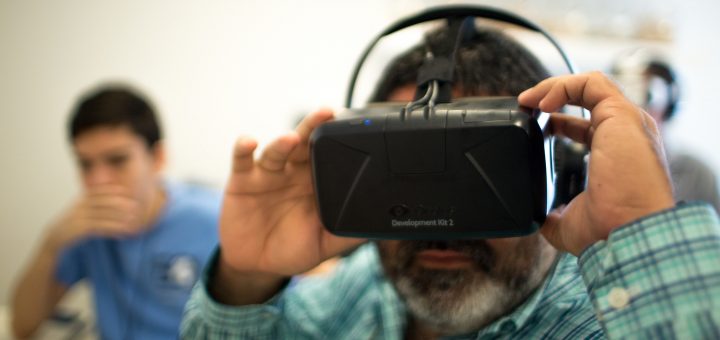How to Choose a VR headset? A Beginners Guide

A Virtual Reality (VR) headset is a heads-up display that lets handlers interact with replicated environments and encounters from a first-person perspective, just as in the physical environment. This kind of simulation is being explored currently by these virtual reality casino games list to provide a more fulfilling experience for players.
Online casinos are embracing aspects of virtual gaming by producing virtual slots and table games aimed at next and newer generation gamblers. This move by online casinos to incorporate simulated gaming is opening the Virtual Reality headset production to an entirely new market. By way of a headset attachment, players can go from one table to another in the simulated casino environment and play a variety of games from live slots, blackjack, and roulette.
When choosing a Virtual Reality headset, it is essential to put into consideration several factors that will ensure the device you acquire is not only compatible with the type of hardware in your possession but also pocket-friendly and efficient. The Virtual Reality headsets vary in complexity with some easy to use, readily available and compatible with smartphones while others are not.
VR headsets are in two general categories that are; mobile economic solutions and premium quality solutions. The type of experience from the two categories is vast and differ from each other albeit entirely. When choosing a VR headset, several dynamics come into play. The factors listed below are some of the important ones to consider.
Purpose
The incentive for the attainment of a Virtual Reality headset is the first factor that influences the choice of a particular VR headset over the other. The intended use determines the complexity of the device as well as the prevalence of efficiency in conducting the required task. Modest tasks will require a less compound VR headset and vice versa is true for complicated tasks such as online casino gaming.
Design
VR Headsets are available in both low, mid-range, and high- end qualities in regards to technology, pricing, and compatibility. When choosing a VR headset design, it is important to note the following:
- Quality of the lens is an influencing factor when acquiring VR headsets. Second-rate quality lenses harm the eyes, therefore, avoid buying the cheap ones. Most of the high-value VR headsets come with small adjustable knobs to help users adjust the focus and also make the headset comfortable. This feature is left out in the low-end sets, but it’s vital primarily for gaming and watching videos.
- The VR Headset should contain proper belts to hold the set against the face properly. It is essential as it helps in adjusting the headset as per the user’s need. If it lacks straps, it has to be held by hand, which can be tiring when used for long periods of time. The belt keeps the set in a fixed position enabling movement and hands-free capabilities. The Samsung and Procus VRs are good examples of Virtual Reality headsets with secure straps. The set acquired should be comfortable for the player with aspects such as weight and material used coming to play, especially those intended for prolonged use.
Budget
The cost of a Virtual Reality headset heavily dictates the type of device for one to buy. The fee not only covers the initial purchase of the headset but that of hardware, software, and accessories to get alongside the VR headsets.
Virtual Reality headsets in the market vary in price as dictated by design. Low- end sets are much cheaper to acquire, and well-suited devices are relatively inexpensive. Premium solution sets are pricier but offer a more fulfilling experience; it is crucial, therefore, for the user to budget within their limits. Getting the cheapest VR headset ranges from 15$-100$ for mobile solutions and 400$-1000$ or more for premium solutions.
Hardware
The device used to simulate virtual reality should be able to deliver high-quality graphics to the Virtual Reality headset for a similar ripple effect. How effortlessly the VR set fits with the available hardware is a significant factor to consider too. For mobile phone use, sufficient room to fit the phone is a prime consideration. Also, the door that holds the phone should be firm enough to secure the phone. Important to note is the number of phones compatible with the set.
It’s advisable to go for the cardboard headsets if the model of the device for use is an old version. Newer models, however, feature a range of compatible Virtual Reality headsets. Google Cardboard headsets are typically the most flexible with most late-model iPhones, Android, and Windows phones. Check before buying to see whether the phone you have fits within the supported range. Mobile providers such as Samsung have VR gears compatible with latest releases in their handsets.
For PC, there’s a variety to choose from including the Windows Reality headsets that got into the market in late 2017. Computers with at least 8GB RAM are most competent for download of VR content. Virtual Reality ready PCs are available on the market, and when the budget allows, it is advisable to buy one when needed for sophisticated virtual ventures.
The accessories needed for the Virtual Reality headset to function smoothly is reliant on the hardware available. Apart from PC gaming, simulated experiences include other forms of video such as fitting cameras proficient for filming in 360 degrees. This component gives users an opportunity to view and edit the footage afterward.
There is a variety of VR headsets available in the market from top-notch brand names that fit within the needs and budget of a beginner user. The elements mentioned above guide users on what to consider when choosing a Virtual Reality headset to achieve the desired results.
